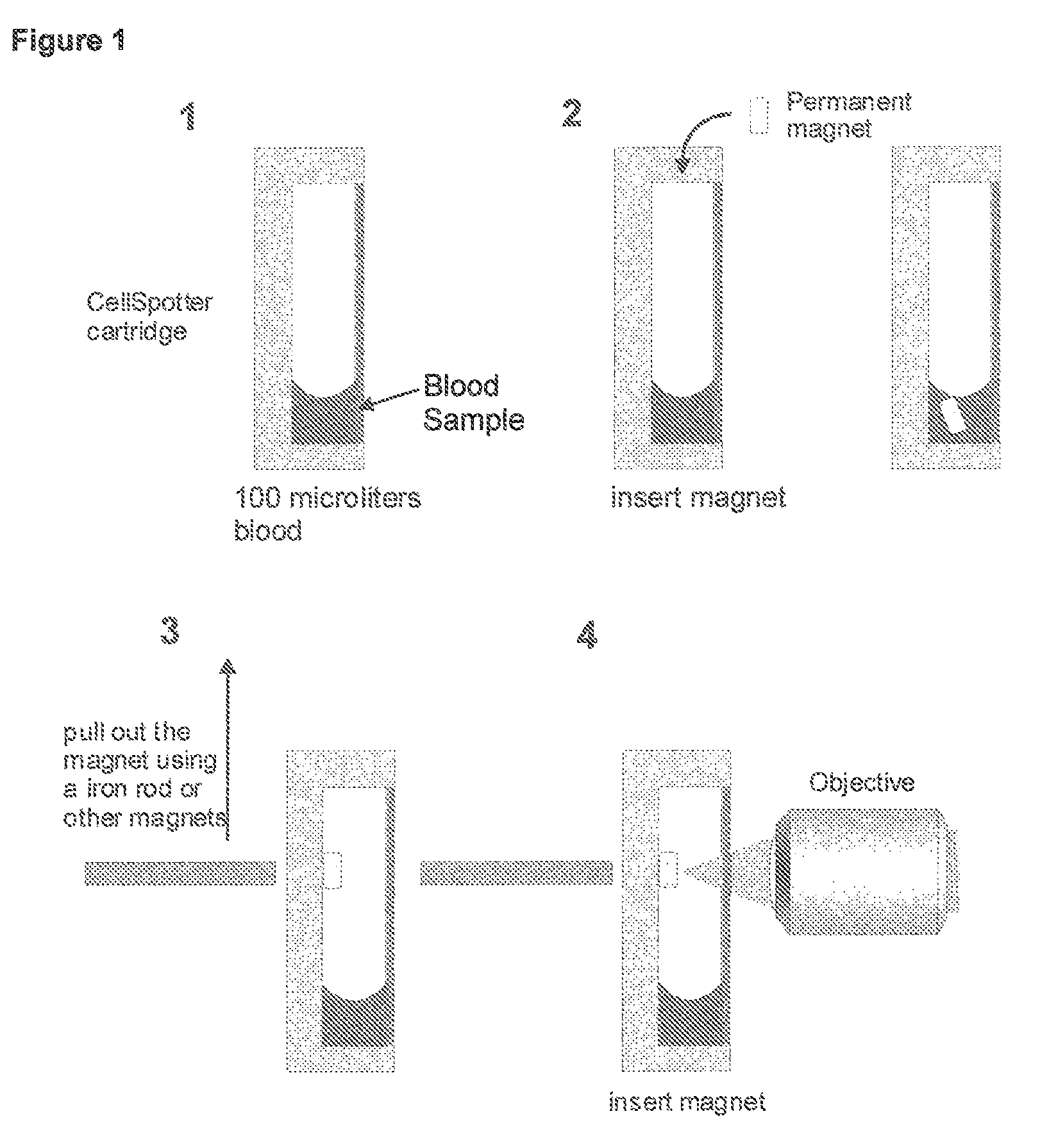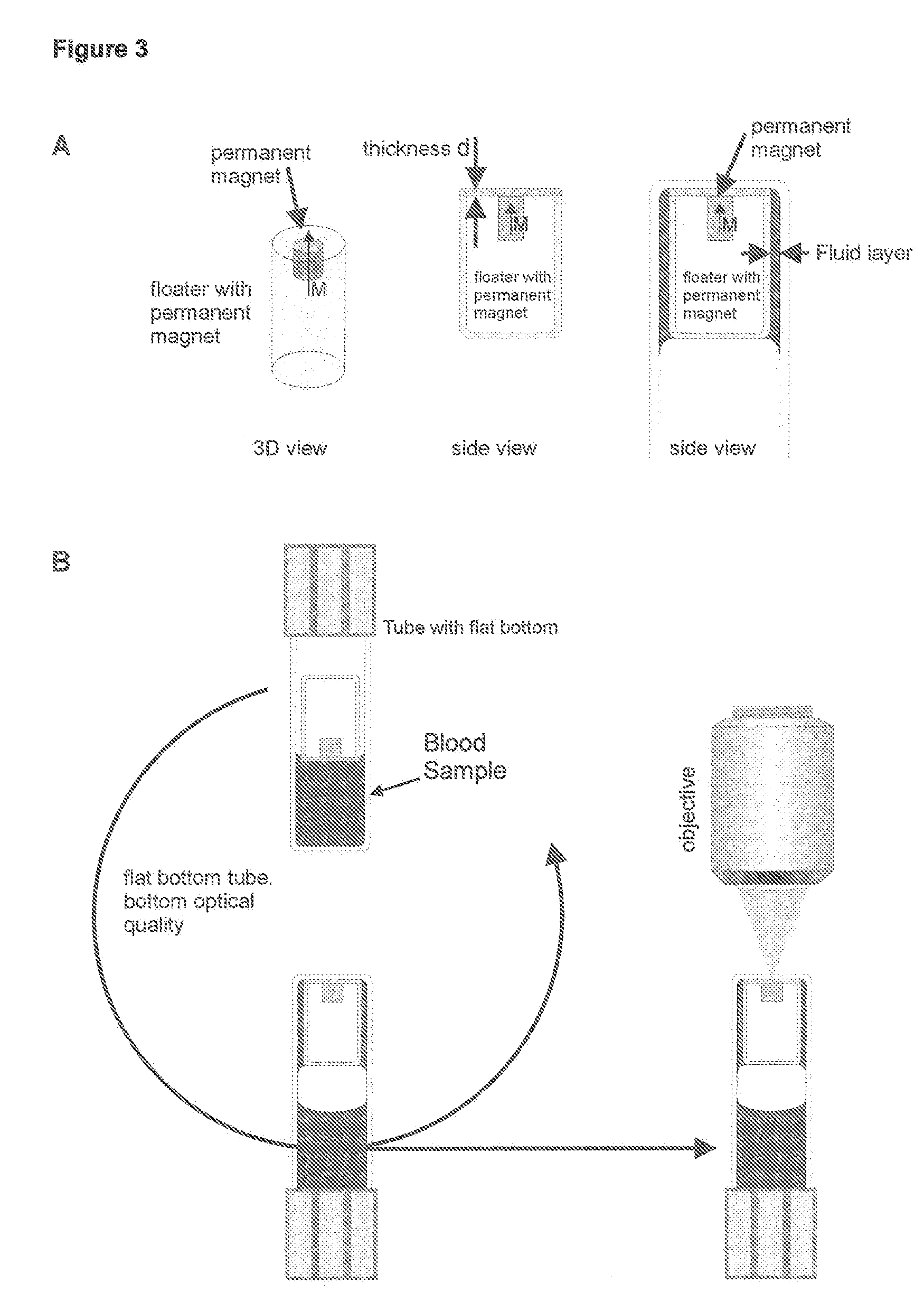Method and apparatus for imaging target components in a biological sample using permanent magnets
a technology of permanent magnets and biological samples, applied in the direction of filtration separation, instruments, separation processes, etc., can solve the problems of low cost, inconsistent reliability, and inability to provide rapid and reliable methods
- Summary
- Abstract
- Description
- Claims
- Application Information
AI Technical Summary
Benefits of technology
Problems solved by technology
Method used
Image
Examples
example 1
[0036]CD-CHEX®, a whole blood assay control, Capture Efficiency To determine the capture efficiency with known absolute numbers of leukocytes and their phenotypes is used.
Materials and Methods:
[0037]CD-CHEX®, a whole blood assay control, (lot # 60650071):[0038]CD3+: 1859 / μl[0039]CD3+ / CD4+: 1221 / μl[0040]CD3+ / CD8+: 576 / μl
[0041]To 50 μl of CD-CHEX®, a whole blood assay control, add 10 μl of CD3-FF (clone Cris7), 10 μl of CD4-APC and 10 μl of CD8-PE. After 25 minutes of incubation, 10 μl of this solution is injected into the chamber. PBS (1.8 ml) is added with 100 μl DAPI. The floater is then inserted. After capping, the chamber is placed on a rocker and rotated overnight (approximately 16 hrs). The chamber is inverted and the images of the floater are acquired.
Results:
[0042]For 100% capture efficiency, the floater surface contains:[0043]CD3+: 10328 cells[0044]CD3+ / CD4+: 6783 cells[0045]CD3+ / CD8+: 3200 cells
[0046]Images are acquired with different objectives and the resulting over-lay i...
example 2
Comparison Between Two Methods for Using Permanent Magnetics
[0047]To determine the imaging of control cells after analysis using a CELLTRACKS® imaging device and a method of inserting and removing a magnetic from the cell suspension (method 1) and using the method with a permanent magnet fixed to a floater (method 2) as described in the present invention.
Materials and Methods:
[0048]After analysis using the CELLTRACKS® System, a system for image analysis of single cells, control cells from the cartridge were transferred to a chamber similar to FIG. 5B. The cartridge was washed several times with PBS using a pasteur pipette and all fluid used in the wash (approximately 500 microliters) was transferred to the chamber. Additional PBS was added to the volume to bring the total volume to 2 ml. Vial was placed on the tube rotator. The rotation speed was set so the floater moved through the entire fluid in one rotation. After complete mixing, 1.5 ml of control cells was injected into the vi...
example 3
Amount of Ferrofluid
[0051]To determine the quality of image with increasing ferrofluid. As the amount of ferrofluid increases the image quality decreases. Cells become buried under a layer of ferrofluid and are invisible for detection. This results, in part, in the low recoveries.
Materials and Methods:
[0052]COMPEL Magnetic Microspheres, Dragon green, 2.914 107 / ml, diameter 8.44 microns, lot#6548 (Bangs Laboratories Inc. Catalog code UMC4F) were diluted 1:100. System buffer (1.5 ml) was added to the glass vial and 50 microliters containing 14570 beads were added together with 20, 40, 60 and 80 microliters of EpCam ferrofluid (20 mg / ml). Fluorescence images were acquired after 15 and 30 minutes of rotation. Test tube rotator was set at 10 rpm, resulting in 150 and 300 rotations.
[0053]Floater is Corning 1 / 16″ diameter magnet.
Results:
[0054]Images are acquired with a 5×, 10× and 40× objectives. As shown in FIG. 8, 5× and 40× objectives were used to image 20 and 40 microliters of EpCam (P...
PUM
| Property | Measurement | Unit |
|---|---|---|
| height | aaaaa | aaaaa |
| diameter | aaaaa | aaaaa |
| thickness | aaaaa | aaaaa |
Abstract
Description
Claims
Application Information
 Login to View More
Login to View More - R&D
- Intellectual Property
- Life Sciences
- Materials
- Tech Scout
- Unparalleled Data Quality
- Higher Quality Content
- 60% Fewer Hallucinations
Browse by: Latest US Patents, China's latest patents, Technical Efficacy Thesaurus, Application Domain, Technology Topic, Popular Technical Reports.
© 2025 PatSnap. All rights reserved.Legal|Privacy policy|Modern Slavery Act Transparency Statement|Sitemap|About US| Contact US: help@patsnap.com



